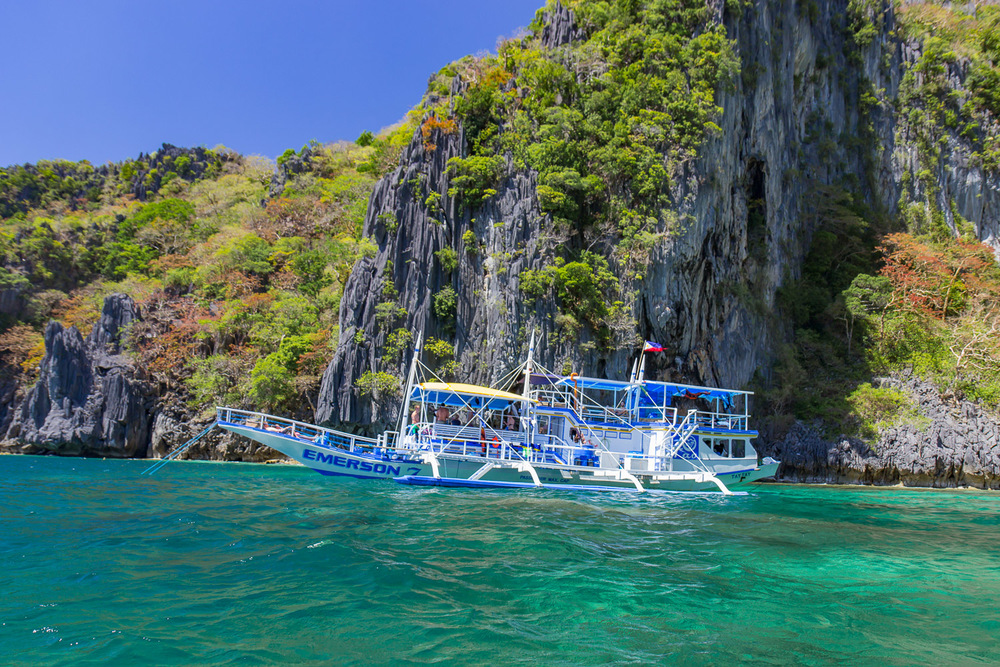In Thailand, we saw some truly awe-inspiring, I-can't-believe-nature-made-this beaches. They were remote, hidden, and had even been featured in movies freaking titled The Beach.
The only hiccup? Those "hidden" beaches were found decades ago. We were sharing them with a few thousand other tourists. And, not to be negative, but it's a little hard to enjoy even the world's prettiest beach when you can barely see the water from where you stand on the sand.
And then we arrived in the Philippines.
In Philippines, we saw beaches just as amazing, if not even more ridiculously beautiful. The difference this time was that there were very few people around. Sometimes, there were no people around. (Thanks to Tao Philippines for brining us to remote islands.)
We found ourselves in a reverse-Castaway situation. We knew there were other people on the island somewhere and that we had a way off... but what if we just sort of hid and waited until they left and then we could stay forever... that was the train of thought.
Now, I'm not just bragging. This post does have a purpose. (At least I think it does. As usual.)
Before we left Denver, we met a couple who had just returned from a year-long trip and had visited a lot of the same places we'd be going. They told us that they had expected to like Thailand a lot more than they did, since they found it overrun with tourists. And, they told us about the incredible month they'd spent in the Philippines, strongly advising that we added it to our list. Did we listen? Sort of.
Sometimes in life, and definitely in the travel-life we've been living, you can't just take someone's word for it. You need to go and see it for yourself. Even if you know what you're getting into, you just need to have the experience firsthand. And so, we planned for four weeks in Thailand and just over two in the Philippines.
Thailand had been at the top of our lists for a long time. The iconic long tail boats, diving in turquoise water, the addictive spicy food... I could go on and on. But because we'd heard from a few different fellow travelers that Thailand was a step beyond well traveled, we tried to keep our expectations in check. Then, before we knew it, three weeks turned into four and we were spending a month there.
We'd never have skipped it. We needed to see it for ourselves. (And we did have some great times. Of course we did.)
When we left, we found ourselves telling other people how we had liked it, but did think it was hard to find a unique experience since the entire country seems so accustomed to catering to tourists. Particularly of the young, wild, on-their-parents-dime variety.
And then we arrived in the Philippines. Obvious differences aside (Philippines is a country made up of 7,000+ islands, Thailand is arguably more accessible, etc.), with minimal expectations for the Philippines, we were blown away.
Immediately after arriving in Coron, our first stop, we felt a refreshed sense of traveler-ness. We didn't see hoards of caucasians teens on iPhones or older couples walking arm in arm with their private guide. There were only one or two "tourist shops" on the main road, instead of occupying every other storefront (or worse, every storefront, a la Bangkok's Koh San Road).
Even though others had offered their friendly advice and told us that the Philippines was better than Thailand - urgently throwing in, "exceptforthefood!" - we still had low expectations for Philippines and very high expectations for Thailand, a county that had been at the top of our list for years.
We obviously didn't see all of either country. Are there parts of the Philippines that suck? Yes, pretty much every large city. Does Thailand have rural countryside waiting to be discovered? Probably.
Maybe it's that we didn't try hard enough in Thailand to escape the well-beaten path and pack of tourists.* Maybe Palawan in the Philippines is still a hidden gem. No matter the reason we found Philippines beaches better than Thailand's*, we did. And we felt obliged to share that information with you.
So, is Philippines the "new" Thailand? I think you'll have to go to both and then decide for yourself. Oh, come on, like you weren't going to anyway...






